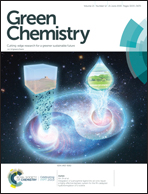Hydrotreatment of biocrudes derived from hydrothermal liquefaction and lipid extraction of the high-lipid Scenedesmus†
Abstract
Biocrudes derived from hydrothermal liquefaction (HTL) and lipid extraction (EXT) of the high-lipid Scenedesmus were hydrotreated to investigate the influences of the feedstock on the profiles of the hydrotreating biofuels. For HTL and EXT biocrudes, similar yields were obtained (52.87% and 49.06%, wt%) but with different fatty acid (60.53% and 66.92%), C (60.28% and 74.40%), H (9.55% and 10.96%), O (26.99% and 13.81%) and N (3.19% and 0.85%) contents (wt%), HHVs (29.19 and 38.33 MJ kg−1) and chemical constituents (fatty acids and triglycerides), respectively. After hydrotreatment, 0.45 g HTL and 0.42 g EXT biofuels were obtained from 1 g Scenedesmus, with different heteroatoms (9.14% and 1.01%) and HHVs (42.77 and 48.85 MJ kg−1), respectively. However, a certain number of heavy products, such as C30+ hydrocarbons and C31+ esters, were found in both biofuels. By adjusting the reaction conditions, including the temperature and catalyst loading, the content of heavy products decreased from a maximum of 26.24% to a minimum of 1.30% at 350 °C with a 50% catalyst loading. Based on the hydrotreating model fatty acids and esters, the proposed reaction mechanism demonstrated that the formation of heavy products could be inhibited using EXT biocrude instead of HTL biocrude as the feedstock.



 Please wait while we load your content...
Please wait while we load your content...